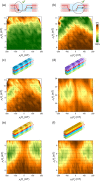Racetrack memory based on in-plane-field controlled domain-wall pinning
- PMID: 28400587
- PMCID: PMC5429776
- DOI: 10.1038/s41598-017-00837-x
Racetrack memory based on in-plane-field controlled domain-wall pinning
Abstract
Magnetic domain wall motion could be the key to the next generation of data storage devices, shift registers without mechanically moving parts. Various concepts of such so-called 'racetrack memories' have been developed, but they are usually plagued by the need for high current densities or complex geometrical requirements. We introduce a new device concept, based on the interfacial Dzyaloshinskii-Moriya interaction (DMI), of which the importance in magnetic thin films was recently discovered. In this device the domain walls are moved solely by magnetic fields. Unidirectionality is created utilizing the recent observation that the strength with which a domain wall is pinned at an anisotropy barrier depends on the direction of the in-plane field due to the chiral nature of DMI. We demonstrate proof-of-principle experiments to verify that unidirectional domain-wall motion is achieved and investigate several material stacks for this novel device including a detailed analysis of device performance for consecutive pinning and depinning processes.
Conflict of interest statement
The authors declare that they have no competing interests.
Figures




Similar articles
-
Increased Efficiency of Current-Induced Motion of Chiral Domain Walls by Interface Engineering.Adv Mater. 2021 Mar;33(10):e2007991. doi: 10.1002/adma.202007991. Epub 2021 Feb 4. Adv Mater. 2021. PMID: 33543527 Free PMC article. Review.
-
Néel domain walls with bistable chirality in a perpendicularly magnetized ferrimagnetic insulator.Nat Commun. 2025 Jun 4;16(1):5201. doi: 10.1038/s41467-025-60412-1. Nat Commun. 2025. PMID: 40467549 Free PMC article.
-
Magnetic bubblecade memory based on chiral domain walls.Sci Rep. 2015 Mar 16;5:9166. doi: 10.1038/srep09166. Sci Rep. 2015. PMID: 25772606 Free PMC article.
-
Shift registers based on magnetic domain wall ratchets with perpendicular anisotropy.Nat Nanotechnol. 2012 Aug;7(8):499-503. doi: 10.1038/nnano.2012.111. Epub 2012 Jul 15. Nat Nanotechnol. 2012. PMID: 22796743
-
Magnetic texture enabled electrical control of Dzyaloshinskii-Moriya interaction in a Weyl semimetal.J Phys Condens Matter. 2025 Apr 1;37(18). doi: 10.1088/1361-648X/adc4a9. J Phys Condens Matter. 2025. PMID: 40127534
Cited by
-
Observation of a topologically protected state in a magnetic domain wall stabilized by a ferromagnetic chemical barrier.Sci Rep. 2018 Nov 12;8(1):16695. doi: 10.1038/s41598-018-35039-6. Sci Rep. 2018. PMID: 30420675 Free PMC article.
References
-
- Zhang Y, et al. Perpendicular-magnetic-anisotropy cofeb racetrack memory. J. Appl. Phys. (Melville, NY, U.S.) 2012;111:093925.
-
- Chiba D, et al. Control of multiple magnetic domain walls by current in a co/ni nano-wire. Appl. Phys. Express. 2010;3:073004. doi: 10.1143/APEX.3.073004. - DOI
LinkOut - more resources
Full Text Sources
Other Literature Sources

